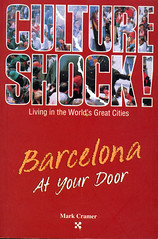Times Media, 2001. 196 páginas.

Para entrar a vivir
¿Qué hago leyendo un libro en inglés sobre la ciudad que vivo? Aprender, claro. La mejor manera de conocer los sitios de tu ciudad es preguntar a alguien de fuera, que ha hecho labor de investigación y te puede enseñar. Con esta intención leí este libro.
En parte me quedé defradudado, ya que su ámbito es tan completo que no me ha aportado cosas nuevas. Pero me ha sorprendido su calidad como manual para desenvolverse por Barcelona. No sólo explica historia, monumentos y demás. También la burocracia, trámites administrativos y un largo etcétera. Lo suficiente para que un extranjero sepa donde tiene que ir para cualquier eventualidad.
No conocía este tipo de guías que no son de viaje, sino de instalación, pero me ha gustado. A destacar también la simpatía procatalana del autor.
Calificación: Muy bueno (para quienes quieran venir a vivir aquí).
Un día, un libro (100/365)
Extracto:
Barcelona’s most controversial decision has been what to do -with Gaudi’s Sagrada Familia. Destiny did not respect the unlimited playful artistic ventures inscribed in Gaudi’s happy calendar, when in 1926 a streetcar ran him down. What to do with his greatest project? Leave it as it -was, unfinished, says one group of purists. Use what is left of his original plans to faithfully complete the monumental structure, say other purists. Finish it, in evolving styles, as Gaudi -would have done had he been alive in the 1980s and ’90s, say the advocates of finishing the project. The latter argument has a solid historical foundation. What they want to do with Gaudi’s neo-Gothic structure -was precisely what was done -with Gothic monuments from the Middle Ages, that took decades or centuries to finish, passing under the direction of different architects, and incorporating distinct architectural periods. From the looks of things, the third option, perhaps purer historically
than the aesthetically purist solutions, has been the fait accompli winner. When it is eventually completed, La Sagrada Familia will be a faithful enactment of medieval architectural history and workmanship.
Another irony is that the Sagrada Familia has become an unstated nationalist image of Barcelona, since Gaudi, unlike his activist and nationalist contemporaries Lluis Domenech i Montaner and Josep Puig i Cadalfalch, «was totally apolitical and couldn’t care less that his great -work was funded with the purposes of expiating his city from the leftist activist sins of the past, much like the Sacre Coeur project in Paris.
Barcelona’s polemical relationship -with its history extends far beyond La Sagrada Familia. After the ornate nineteenth century opera house Gran Teatre del Liceu, whose innards were gutted by fire in 1994, -was restored to its original design, Mr. Juan Bea Girons commented in La Vanguardia that «the deficiencies of making the Liceu ‘the same, and in the same place’ has produced defective results and many disillusioned season ticket holders … Nostalgia has been very expensive.»
Our preliminary chronological stroll through Barcelona finally rests at the Centre de Cultura Contemporania de Barcelona, opened in 1994: the first cultural center in Europe dedicated exclusively to the subject of cities and urban culture as a whole, on Montalegre Street, only two twisting blocks -west of Placa Catalunya. (Info in English: http://www.cccb.org/ingles/ mformac.htm)
No hay comentarios